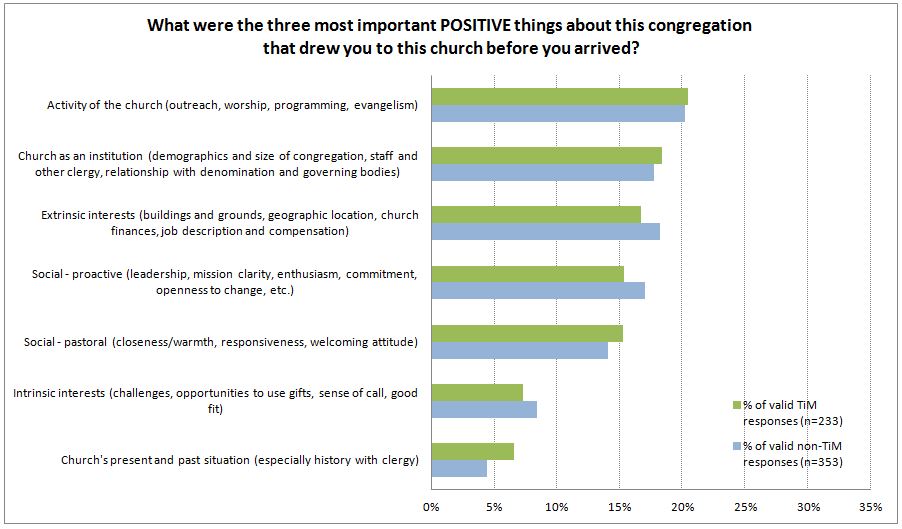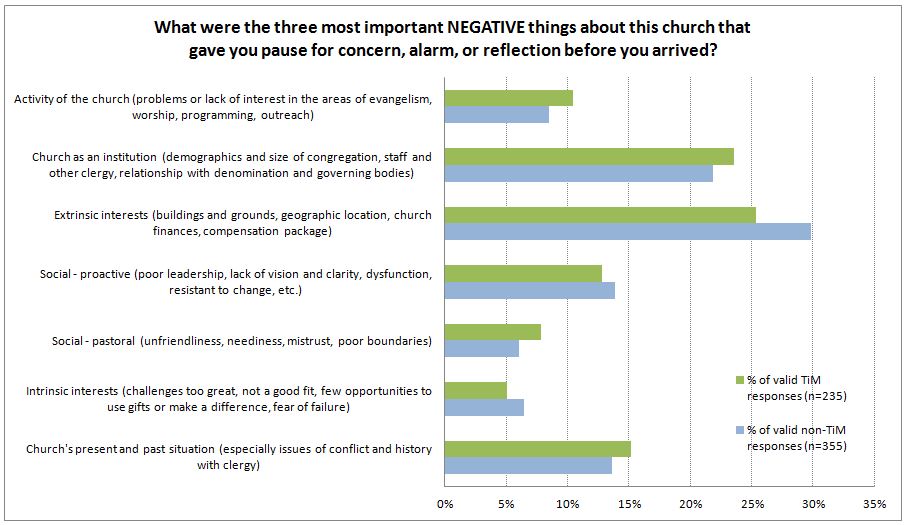Clergy describing their first impressions of a church where they accepted a call generally focus on the same types of issues, with minor exceptions, whether they have participated in a Transition into Ministry (TiM) program or not, our study found.
For this analysis, we categorized clergy survey responses in ways that mirrored the categories used in a previous study, so that we would be able to compare the results of the two studies.
In the earlier study, Episcopal priests answered similar questions about their first impressions, unaware that they had been nominated by their peers and supervisors either as being effective leaders or as struggling in their ministries.
That study concluded that effective clergy pay greater attention to positive signals about the level of activity in a congregation, and also to indications that the people there are generally proactive. Struggling clergy tend to focus more on extrinsic factors.1
The current Clergy Into Action Study found that the responses from both the TiM alumni and the other new clergy generally followed the patterns of the effective clergy group in the previous study. We did not find evidence that TiM alumni have significantly more in common with the effective clergy group than other new clergy do.
We saw the following minor differences between TiM participants and non-participants:
- TiM participants were less likely than non-participants to report either positive or negative impressions of the extrinsic aspects of a call, such as geographic location or the description of the job offered.
- The responses from TiM alumni indicate they pay slightly more attention than other new clergy to the activities planned or taking place at the church, to the demographics and size of the congregation, and to ongoing or past situations at the church that might reveal something about the nature of the congregation.
- However, our control group of new clergy who did not participate in TiM programs submitted a higher percentage of responses concerning whether members of the congregation were proactive; typical comments mentioned the strength of lay leadership, whether the congregation had a clear sense of its own mission and identity, how open to change church members were, etc.
- The control group also rated slightly higher on attention paid to intrinsic factors. This category includes comments about feeling a strong sense of call to serve this particular congregation and about believing the position would offer an exciting challenge or opportunities to use one’s gifts.
Asked to recall their three most important positive impressions of the church where they would later work, both groups frequently submitted answers about actions and activities of the congregation: efforts to reach out to the community, church programming priorities, and the style and spirit of worship services.
Also common were positive answers about
- the church as an institution (especially its staff, size, and demographic makeup);
- extrinsic factors such as geographic location and the description of the job offered; and
- qualities seen in the people of the congregation that would allow for growth, change, and renewal.
Then we asked about the expected downsides of employment at that specific church. More than 25% of the answers from clergy in both groups were about extrinsic concerns: an undesirable geographic location, an uninspiring job description, or financial difficulties faced by the congregation.
Negative impressions of the church as an institution were also fairly common, comprising more than 23% of all valid responses from TiM alumni and 21% from non-participants. Ministers reported feeling hesitant to answers calls from churches that seemed limited by the demographics of their congregations (especially age), the size of their congregations, and their staffs, including other clergy.
The previous study suggested that effective clergy are more likely to perceive potential problems at a church as challenges or opportunities for change and renewal. They also look for signs that the people in the congregation are open to change and have the energy and commitment to make change happen.
Struggling clergy, however, often make their decisions based on extrinsic factors such as a satisfactory compensation package, a geographic location that suits the needs of a spouse or family, or the church’s financial stability.
Related Articles
- Research: First Impressions of a Church: New Clergy Focus on People First
- Research: Meeting a New Congregation: Clergy Look for Openness to Change and Friendliness to Outsiders
1 John Dreibelbis and David Gortner, “Markers of Strong and Effective Clergy Leadership: Preliminary Findings” (research report presented at the 2002 Conference of the Consortium of Endowed Episcopal Parishes, New Orleans, LA, February–March 2002).




